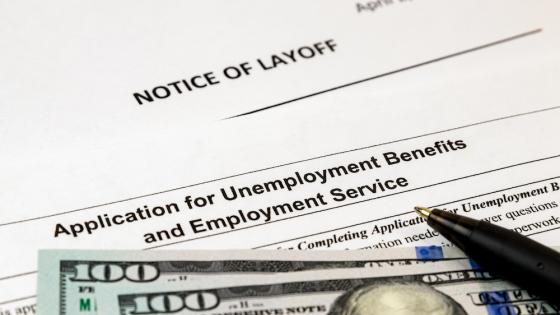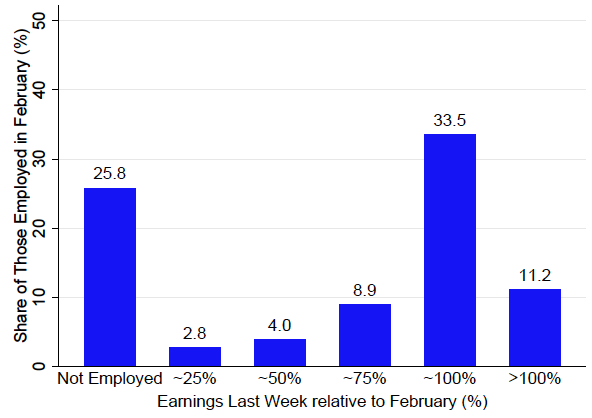The 2019-2020 coronavirus outbreak has prompted a sharp economic downturn in the US and around the world. As advocated in Baldwin and Weder di Mauro (2020), governments need to “act fast and do whatever it takes” to mitigate the economic crisis. Effective policies require timely and accurate data on the scale of the downturn, yet traditional data sources are only made available with a significant lag. For example, the most recent report by the Bureau of Labor Statistics (BLS) reflects labour market outcomes from 8-14 March, which precedes the major economic effects of the outbreak. The next BLS report will be released on Friday 8 May, but this will reflect outcomes from 12-18 April and so will already be three weeks old on the day it is released. Then we will not have new data until the next report is released on 5 June. The gap between the data needs of policymakers and the time lag of traditional data sources has left policymakers ‘flying blind’ to a significant degree.
Our real-time population survey
The goal of this project is to help fill that void. To do so, we collect online survey data every other week from a sample representative of US adults. The first two survey waves cover the weeks of 29 March-4 April (1,100 respondents) and 12-18 April (2,000 respondents); our third survey wave is in progress at press time, and covers the week of 26 April-2 May. We refer to our survey as the Real Time Population Survey (RPS) and the most up to date results can be found on the website dedicated to the project at https://sites.google.com/view/covid-rps/.
The core of our RPS survey closely follows the core labour market questions in the BLS’s primary household survey, the Current Population Survey (CPS). Because we closely follow the CPS, we can compute labour market estimates consistent with the government measures. This means that our results can be viewed as real-time predictions of the official government statistics, except available up to six weeks ahead of time and updated twice as often. This is one of the key distinctive features compared to other recent studies using online surveys to gauge the state of the US labour market (e.g. Coibion et al. 2020, Adams et al. 2020, Bell and Blanchflower 2020). We also include a suite of questions specifically tailored to the present economic situation which are not asked by the CPS.
A real-time prediction of the April BLS report
The April BLS report, which will be released on Friday 8 May, covers the week of 12-18 April. The second wave of our RPS survey covers this same week, but we were able to publish the results on 24 April. Our estimates, summarised in Bick and Blandin (2020), suggest that the April BLS report is likely to reveal unprecedented devastation in the US labour market.
We find that the share of working age adults (18-64) who were employed declined from 72.7% in 8-14 March to 55.8% in 12-18 April (see Figure 1). That is, roughly one out of every four adults who was working in mid-March was no longer employed by mid-April. This would imply 34 million fewer people employed in April relative to March.
Figure 1 Employment rate aged 18-64
Notes: Data from 12 January-8 March (grey) are derived from CPS surveys. More recent data (blue) are derived from responses to our online RPS survey. The 95% confidence interval for our most recent estimate is (53.9%, 57.8%).
The scale and speed of this change has no modern equivalent. For reference, the employment rate among working age adults fell by roughly 6 percentage points during the Great Recession, but this decline took place over several years, from the beginning of 2007 until the end of 2009. By contrast, our estimates suggest that the decline in employment just last month was 2-3 times larger than during the Great Recession.
Our employment estimates are broadly consistent with other pieces of evidence. For example, each week the US Department of Labor publishes the number of new claims for unemployment insurance (UI) throughout the country. Between 15 March and 18 April, Americans filed roughly 24 million new UI claims. While this number is about 29% lower than our estimate, there are several reasons why we might expect new UI claims to understate the decline in employment. It may simply take a few days or weeks for individuals who just lost their job to file a claim, especially amid recent reports of overwhelmed state unemployment agencies. Further, although recent legislation has expanded the number of workers who are eligible for unemployment insurance, some workers may not know they are eligible (e.g. the self-employed and gig workers).
In addition to the striking decline in employment, our findings thus far point to three other key takeaways.
- First, we estimate a large decline in the labour force participation rate (LFP). The LFP measures the share of adults who are in one of two bins: either (1) working, or (2) not working but are available to work and actively looking for work. In normal economic downturns, the LFP is relatively flat because people who lose their jobs will simply look for another one – that is, they stay in the labour force and simply move from bin (1) to bin (2). However, in the present environment some people who lose their job may choose to not search for another job for a time, either out of health concerns or because they are waiting for work restrictions to be lifted. This has important implications for how to interpret the unemployment rate, which measures the share of the labour force who is not working: if many individuals who have lost their job stop looking for work, they will be classified as ‘out of the labour force’, which will counterintuitively lower the unemployment rate. This is also often referred to as the ‘discouraged worker’ effect.
- Second, the aggregate supply of labour has declined by even more than suggested by the employment rate alone. The aggregate supply of labour is the product of two components: the number of employed and the average hours worked per employed person. According to our RPS survey, roughly 20% of the decline in aggregate labour supply between March and April was due to lower hours per employed.
- Third, many of those who are still working report losses in their earnings (see Figure 2). Overall, 42% of respondents reports lower labour earnings mid-April compared to one month prior; 25.8% had no labour earnings because they were not working at all; the other 15.7% were still working but earning less.
Figure 2 Earnings changes among those working in February, age 18-24
Notes: Results are derived from responses to the 12-18 April wave of our online RPS survey from workers who report that they were employed in February 2020. 13.8% of respondents reported that they were unsure of how their earnings last week compared to their usual weekly earnings prior to March 2020.
Looking ahead
We will publish a new draft this Friday 8 May, which will contain two new sets of results. First, it will include the results from the April BLS report, which will provide the first major test of the accuracy and usefulness of the RPS. Second, we will display the results from our third survey wave, which estimates labour market conditions for the week of 26 April–2 May. Our intention is to continue running new waves of the survey every other week, with the goal of providing policymakers and researchers high frequency observations of the labour market in near real time.
References
Adams-Prassl, A, T Boneva, M Golin, and C Rauh (2020), “Inequality in the Impact of the Coronavirus Shock: Evidence from Real Time Surveys” (see also the Vox column here).
Baldwin, R and B Weder di Mauro (2020), Mitigating the COVID Economic Crisis: Act Fast and Do Whatever It Takes, A VoxEU.org eBook, CEPR Press.
Bell, D and D Blanchflower (2020), “US and UK Labour Markets Before and During the COVID-19 Crash”, National Institute Economic Review No. 252
Bick, A and A Blandin (2020), “Real Time Labor Market Estimates During the 2020 Coronavirus Outbreak”, Working Paper
Coibion, O, Y Gorodnichenko and M Weber (2020), “Labor Markets During the Covid 19 Crisis: A Preliminary View,” working paper (see also the Vox column here).






